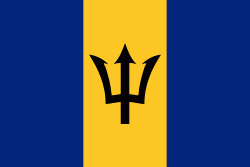Barbados dollar
$
The dollar has been the currency of Barbados since 1935. Globally its currency has the ISO 4217 code BBD, however, unofficially in Barbados the International vehicle registration code BDS is also commonly used, a currency code that is otherwise reserved for Bangladesh (ISO 3166-1 country code BD) outside Barbados. As such the present dollar has the ISO 4217 code BBD. The Barbadian dollar is divided into 100 cents.The history of currency in the former British colony of Barbados closely follows that of British Eastern Caribbean territories in general. Even though Queen Anne's proclamation of 1704 introduced the pound sterling currency system to the West Indies, silver pieces of eight (Spanish dollars and later Mexican dollars) continued to form a major portion of the circulating currency right into the latter half of the nineteenth century.
Britain adopted the gold standard in 1821 and an imperial order-in-council of 1838 resulted in Barbados formally adopting the British sterling coinage in the year 1848. However, despite the circulation of British coins in Barbados the silver pieces of eight continued to circulate alongside them and the private sector continued to use dollar accounts for reckoning. The international silver crisis of 1873 signalled the end of the silver dollar era in the West Indies and silver dollars were demonetized in Barbados in 1879. This left a state of affairs, in which the British coinage circulated, being reckoned in dollar accounts at an automatic conversion rate of 1 dollar = 4 shillings 2 pence. The first currency denominated in dollars to be issued in Barbados was in the form of private banknotes introduced in 1882. No subdivisions of the dollar were issued and these notes circulated alongside sterling, together with 1 pound notes issued by the government in 1917. From 1920, some of the private banknotes also carried a denomination in sterling, with 1 dollar = 4 shillings 2 pence.
From 1949, with the introduction of the British West Indies dollar, the currency of Barbados became officially tied with those of the British Eastern Caribbean territories in general. Between 1938 and 1949, the Barbadian government issued paper money denominated in dollars. The last private bank issues were made in 1949. The British sterling coinage was eventually replaced by a new decimal coinage in 1955, with the new cent being equal to one half of the old penny. In 1965, the Eastern Caribbean dollar replaced the British West Indies dollar in Barbados.
The present dollar was created after the establishment of the Central Bank of Barbados (CBB), which was founded by an Act of parliament in May, 1972. The Barbados dollar replaced the East Caribbean dollar at par in 1973. Since 5 July 1975, the Barbados dollar has been pegged to the US dollar. It is presently fixed at an exchange rate of US$1 = BDS$1.98. However, some businesses accept US dollars at an exchange rate of US$1 = BDS$2.
For a wider outline of the history of currency in the region, see Currencies of the British West Indies.
Country
-
Barbados
Barbados is an island country in the Lesser Antilles of the West Indies, in the Caribbean region of the Americas, and the most easterly of the Caribbean Islands. It occupies an area of 432 km2 and has a population of about 287,000 (2019 estimate). Its capital and largest city is Bridgetown.
Inhabited by Kalinago people since the 13th century, and prior to that by other Amerindians, Spanish navigators took possession of Barbados in the late 15th century, claiming it for the Crown of Castile. It first appeared on a Spanish map in 1511. The Portuguese Empire claimed the island between 1532 and 1536, but abandoned it in 1620 with their only remnants being an introduction of wild boars for a good supply of meat whenever the island was visited. An English ship, the Olive Blossom, arrived in Barbados on 14 May 1625; its men took possession of the island in the name of King James I. In 1627, the first permanent settlers arrived from England, and Barbados became an English and later British colony. During this period, the colony operated on a plantation economy, relying on the labour of African slaves who worked on the island's plantations. Slavery continued until it was phased out through most of the British Empire by the Slavery Abolition Act 1833.
